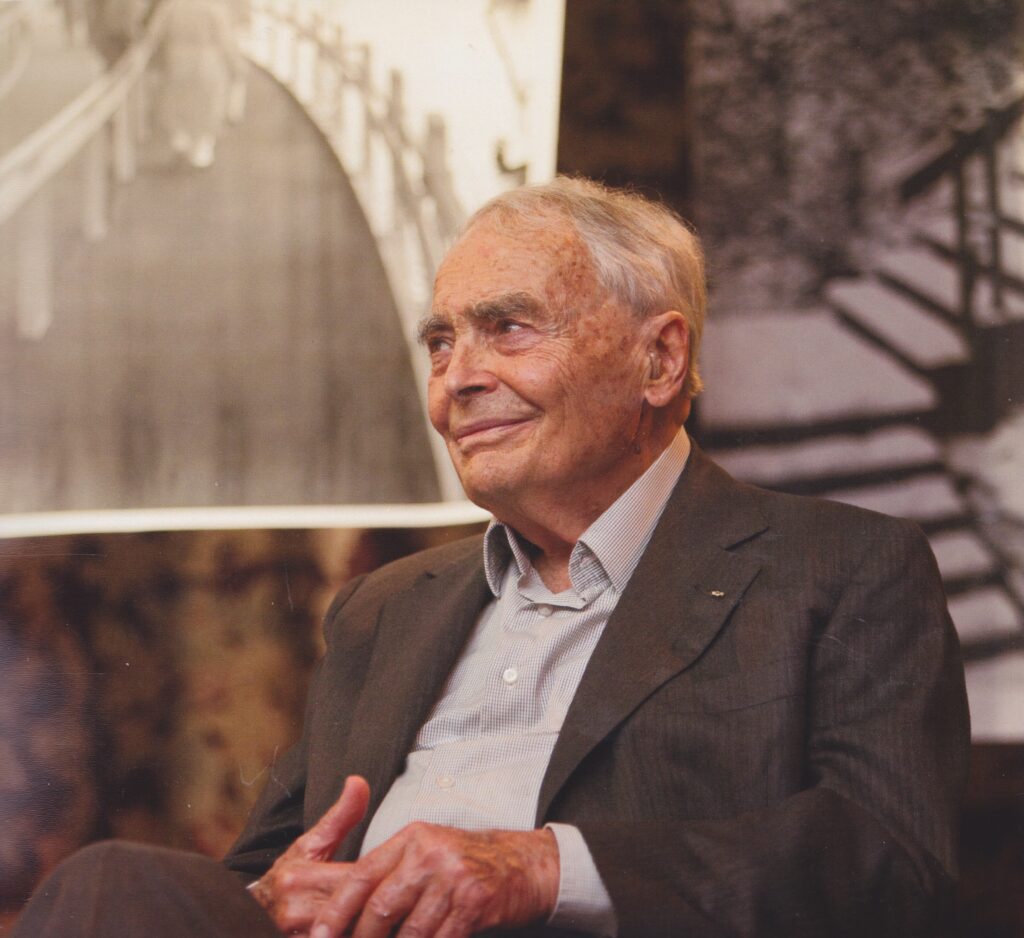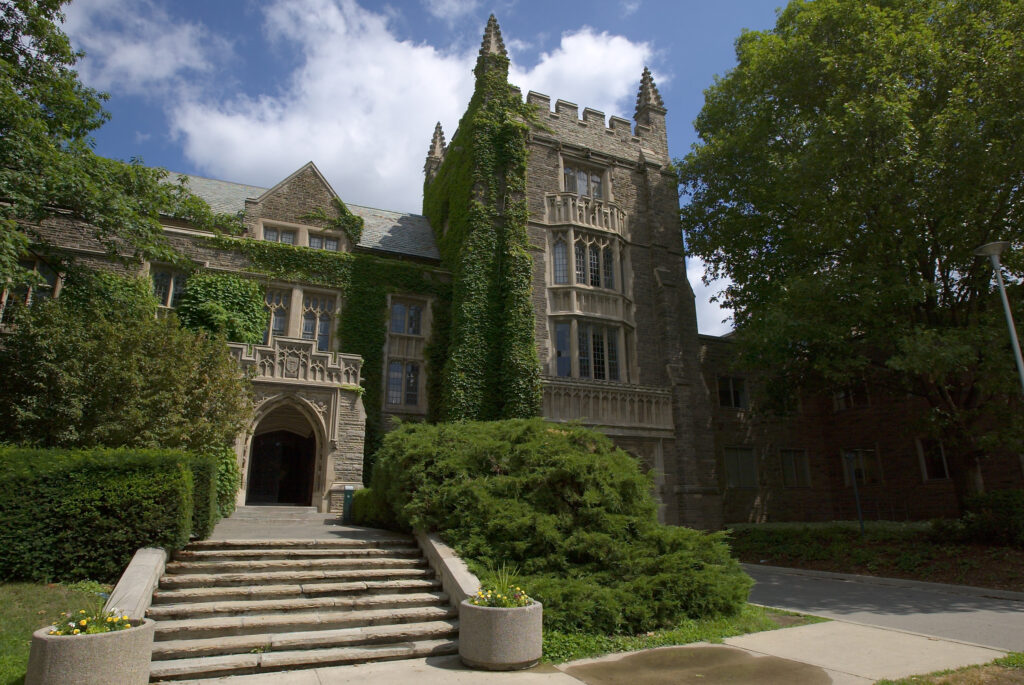Overview
The relationship between architecture and health care, including research and education, is being examined in a new lecture series at McMaster University.
The Architecture of Health: The Annual Zeidler-Evans Lecture series is sponsored by the family of John Evans, the first dean of the university’s Michael G. DeGroote School of Medicine, to honour Eberhard Zeidler, the architect of the McMaster University Health Sciences Centre (HSC) which was built for the university’s medical school and health sciences and as a major hospital.
The 2023 lecture will address innovative approaches to health education, research, and/or care through the design, use and analysis of physical space, with a particular focus on social determinants of health and their connection to space.
Eberhard Heinrich Zeidler (1926-2022)
Eb Zeidler designed some of Canada’s most iconic buildings, from the Toronto Eaton Centre and Ontario Place, to SickKids Hospital and Vancouver Place.
Emigrating from Germany in 1951, he practiced with Peterborough, Ontario practice Blackwell and Craig, which relocated to Toronto in 1963 and became Craig, Zeidler & Strong. The firm became an international operation, with projects ranging from the Kravis Center for the Performing Arts in West Palm Beach to Yerba Buena Gardens in San Francisco and Media Park in Cologne. The firm currently continues under the name Zeidler Architecture.
Zeidler’s design for McMaster University’s Health Sciences Centre opened in 1972 transformed the design of hospitals by acknowledging that medicine changes over time, and thus medical buildings have to change their forms and uses as they’re being used. The World Hospital Congress called the McMaster facility “obsolescence-proof.”
In recognition of his excellence, Zeidler was made an Officer of the Order of Canada, received a gold medal from the Royal Architectural Institute of Canada and was awarded an Honorary Doctorate in Architecture by the University of Toronto also.

John Robert Evans (1929-2015)

John Evans was a renowned doctor, academic, business and civic leader.
In 1965, the Rhodes scholar was asked to become the founder and dean of the McMaster University Medical School. He and his team of colleagues built a different type of medical school with small group, self-directed, problem-based learning, and the ‘McMaster Method’ has been adopted in whole or part by medical schools around the world.
Part of initiating the school, now called the Michael G. DeGroote School of Medicine, was building a unique building on McMaster’s west Hamilton campus that combined both a major hospital and the research and teaching for several health sciences programs including medicine and nursing.
In 1972, on the opening of the McMaster University Medical Centre and the graduation of the first medical school class, Evans left to be president of the University of Toronto.
The John R. Evans Chair in Health Sciences Educational Research and Instructional Development has been held by Dr. Anthony Levinson since 2004.
In 1979 he became the founding Director of the Population, Health and Nutrition Department of the World Bank in Washington, DC. In 1987 Dr. Evans became the first Canadian to chair the Rockefeller Foundation which he led for eight years.
Following his medical and academic careers, he became a business leader, chairing Allelix Biopharmaceuticals Inc., Torstar Corporation and Alcan Aluminum Ltd. He also chaired and helped create the MaRS Discovery District in Toronto.
The John R. Evans Chair in Health Sciences Educational Research and Instructional Development has been held by Dr. Anthony Levinson since 2004.
McMaster Health Sciences Centre
Master University’s Health Sciences Centre “designed never to be finished”

It was architect Eberhart Zeigler who said of the McMaster Health Sciences Centre that the solution for the difficult problem of future needs was to produce a building “designed never to be finished”.
This 1.3 million square foot building sitting on the west Hamilton, Ontario campus of McMaster University continues to realize that vision.
Built to cater to changing needs of patients and staff of a major academic teaching hospital and the faculty and students of a new, innovative medical school plus a thriving nursing school, the building has been stretched and updated since opening 50 years ago.
Eb Zeidler of Craig, Zeidler and Strong was brought in by John Evans, first dean of McMaster’s medical school in the fall of 1967. This was after discontent with another firm’s proposal of a traditional hospital building that didn’t reflect the revolutionary focus of the new medical school’s small group, self-directed, problem-based learning and emphasis on engagement in patient-centred care.
It was a novel idea to recognize that change is a constant in medical science and the building needed interiors free of structural support walls so space could change to accommodate an outpatient clinic, an operating suite, nuclear research or a classroom. Zeidler’s space-frame construction has interstitial spaces between the four floors and tower-like shafts for mechanical and electric services to allow for the flexibility.
Built in the Brutalist style popular at the time, the centre opened in June 1972 with a ribbon cutting attended by then Ontario premier Bill Davis, McMaster president Harry Thode, medical school dean John Evans, architect Eberhart Zeigler, and hundreds of Hamilton citizens who lined up for the open house.
The building has been recognized in architectural journals as presenting a visionary approach to health care architecture and a turning point in Canadian medical history — the shift from hospital to health science centre.
Expandable List
The building has 1,335,433 square feet of useable space, still the largest building on campus.
Construction of the building, including its underground parking, cost $61.4 million, with a cost per square foot of $42.39.
It was anticipated there would be 830 to 900 students, and research had 403,000 square feet of space.
The Faculty of Health Sciences began in 1974 with the medical and nursing schools and its first graduate programs. The School of Rehabilitation Sciences and several health professional programs, including Canada first midwifery and civilian physician assistant programs, have been added. Student enrolment is more than 6,000 learners a year by 2022.
Although the Faculty now occupies the majority of six additional buildings, its administrative centre is still in the Health Sciences Centre.
MUMC (McMaster University Medical Center) opened as a 420-bed community hospital with a focus on family practice, obstetrics, pediatrics, psychiatry, medicine and surgery.
The McMaster Children’s Hospital was established in the building in 1988.
The regional hospital system of Hamilton Health Sciences created in 1996 includes MUMC as a major tertiary hospital serving the catchment area of Tobermory to Niagara Falls.
In 2010, the hospital portion of the building changed to specialize in women’s health and gastroenterology patients, and with more focus on the McMaster Children’s Hospital, one of Canada’s busiest pediatric hospitals.
As planned, use of the building has been modified over the years, with one of the largest changes being a $8.6 million renovation to the Health Sciences Library in 2007, including removing a concrete wall on the north side for the two-storey, glass-walled Jan and Mein Heersink Reading Pavilion.
The building’s distinction has been recognized:
- 1969 – Award of Excellence for Projects in the Design Stage to Craig, Zeidler and Strong by the Canadian Architecture Yearbook
- 1971 – Award of Excellence, Ontario Furniture Design Award to Craig, Zeidler and Strong
- 2007 – Award of Excellence in Architecture, Urban Design & Architecture Awards of the City of Hamilton to the McMaster Health Sciences Library
- 2014 – Landmark Designation Award, Ontario Association of Architects
McMaster University

McMaster University was founded in 1887 through a bequest from the estate of Senator William McMaster.
It moved from Toronto to the west side of Hamilton, ON in 1930.
McMaster is one of four Canadian universities listed among the Top 100 universities in the world, and renowned for its innovation in both learning and discovery.
It has a student population of 34,000, and more than 195,000 alumni in 162 countries.
The Michael G. DeGroote School of Medicine has a global reputation for educational advancement and is internationally known for its research intensity and development of evidence-based medicine.
The Faculty of Health Sciences includes the medical school, the School of Nursing and School of Rehabilitation Science, along with health professional programs in midwifery and physician assistant and several graduate programs.
McMaster is ranked in the top 50 universities of the world for health and medicine by four international university ranking systems.

